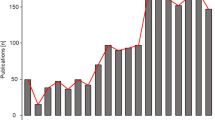Abstract
The relation and collaboration of human and animal medicine had its ups and downs throughout history. The interaction between these two disciplines has been especially fruitful in the broad areas of patho-physiology and of epidemiology. An exploration of the interaction between the two disciplines, using historical and contemporary examples in comparative medicine, zoonoses, zooprophylaxis, and human-animal bond, reveals that a better understanding of animal and human disease, as well as societal changes such as interest in non-conventional medicine, are leading to a broader concept of one medicine that includes animal and human medicine as well as social and other sciences.
Similar content being viewed by others
References
Bernard, S. (1995). Animal Assisted Therapy: A Guide for Health Care Professionals and Volunteers. Davis: University of California Press.
Borrel, A. (1983). Étre véterinaire aujourd'hui. Évolution and présences actuelles d'une profession. Toulouse: Éres.
Dunlop, R. H. and D. J. Williams (1996). Veterinary Medicine: An Illustrated History. St. Louis: Mosby
Eisenberg, D. N., R. C. Kessler, C. Foster, E. E. Norlock, D. R. Calkins, and T. L. Delbanco (1993). “Unconventional medicine in the United States: Prevalence, costs and patterns or use,” New England Journal of Medicine 328: 246–252.
Houlihan, P. F. (1996). The Animal World of the Pharaohs (pp. 1–9). London: Thames and Hudson.
Landry, D. (1978). “Role adaptation: Traditional curers under the impact of western medicine,” in M. H. Logan and E. E. Hunt (eds.), Health and Human Condition: Perspectives on Medical Anthropology (pp. 217–241). Belmont, CA: Wadsworth Publishing Co.
Nelson, G. S. (1974). “Zooprophylaxis with special reference to schistosomiasis and filariasis,” in E. J. L. Soulsby (ed.), Parasitic Zoonosis. Clinical and Experimental Studies (pp. 273–285). New York and London: Academic Press.
Schoen, A. M. and S. G. Wynn (1997). Complementary and Alternative Veterinary Medicine. St. Louis: Mosby.
Schwabe, C. W. (1978). Cattle, Priests and Progress in Medicine. Minneapolis: University of Minnesota Press.
Schwabe, C. W. (1984). Veterinary Medicine and Human Health (3rd Edition). Baltimore: Williams and Wilkins.
Schwabe, C. W. (1993). “Interaction between human and veterinary medicine: Past, present and future,” in Advancement of Veterinary Medicine: The Bicentennial Symposium 1991 (pp. 119–133). Oxford: CAB International.
Schwabe, C. W. (1996). “Ancient and modern veterinary beliefs, practices and practitioners among Nile Valley peoples,” in C. M. McCorkle, E. Mathias, and T. W. Schillhorn van Veen (eds.), Ethnoveterinary Research and Development (pp. 38–45). London: Intermediate Technology Publications.
Author information
Authors and Affiliations
Rights and permissions
About this article
Cite this article
Schillhorn van Veen, T.W. One medicine: The dynamic relationship between animal and human medicine in history and at present. Agriculture and Human Values 15, 115–120 (1998). https://doi.org/10.1023/A:1007478809782
Issue Date:
DOI: https://doi.org/10.1023/A:1007478809782




